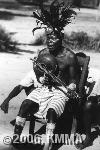


The stick zither is a chordophone consisting of a string stretched over a fingerboard or neck mounted on top of a round sound box. Since it is a zither, the sound box can be dismantled without the string being removed. The string is tied and wound at both ends of the fingerboard. The fingerboard is then again bound to the sound box, a hollowed half-open calabash, with a piece of string which, threaded through two small holes, is knotted inside the calabash. A funnel-shaped piece from the neck of the calabash is usually placed between the fingerboard and the sound box; on the one side in close contact with the calabash, and on the other side there are two groves in which the fingerboard is laid, making it more stable. The fingerboard is cut out of a straight piece of wood, broadened or raised at both ends for the purposes of attaching the string and in some cases decorated with geometric motifs. Three keys are left open close to the end furthest from the sound box. Generally the stick zither has one string, although it may be as many as two to four. One of these strings is the melodic string, while the others are used as sympathetic strings and vibrate to enrich the timbre of the instrument. Pressing the string against one of the three keys while playing shortens the length of the string and can make a difference in pitch. The open string and the three keys therefore give a total of four different pitches. The string is generally made from twisted vegetable fibres.
The stick zither is played in large areas of the Congo, but not in the western border areas. The instrument was supposedly introduced by Arabic merchants from East Africa. This instrument type has equivalents in form and design in South and South-East Asia, and this adds to the theory that cultural contacts already existed centuries ago between East Africa and South-East Asia. In some tribes only men play this instrument, and in others it is only women. However, the stick zither is always combined with singing, and this is frequently to accompany dancing. Sometimes a second person plays a rhythmic accompaniment with a rhythm stick on the sound box. The musician holds the stick zither so that the open side of the sound box rests on his chest. He holds the fingerboard horizontally in front of him and can easily press the string onto the key with one hand while he plucks the strings with the other. There may be regional differences in the playing methods.
This type of instrument is used in recordings of our sound archives made with the Congolese peoples mentioned hereafter where it appears with the following vernacular names:
Bafili (Bali, Kumu), Bapili (Mbuti), Enanga (Nande), Enzenze (Nande), Esanzo (Mongo), Inanga (Lega, Rundi), Inanga (Kinubi) (Hutu), Kingwandikila (Bembe), Langangu (Mbunda), Lulanga (Shi), Lunzenze (Luba-Kasai), Mafili (Bafili) (Pygmées), Nanga (Banyoro), Nedongu (Mangbetu), Ngombi (Segwirunibia) (Zande), Ngyela (Luba), Nzenze (Bira), Nzenze (zeze) (Lega), Seki (Mombutu), Zeze (Tembo)
Discography:
© KMMA